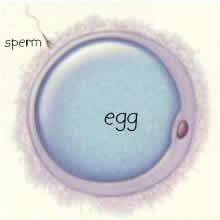Experiment 1: Defining parental contributions |
As with humans, most animals and plants come in two distinct sexes, male and female. The two sexes are defined (soley) by the relative sizes of their germ cells, known as gametes. Females produce large germ cells, known as oocytes, which mature into eggs. Males produce spermatocytes, which become smaller and motile sperm. Sperm are generally produced in much greater numbers than are eggs. These cells fuse together to form a new organism. |
 |
An important step in the resolution of the relative contribution of the two sexes to the next generation was the realization that reproduction in plants also involves male (pollen) and female (ovules) elements. In 1761 Joseph Kölreuter used true breeding plant varieties to determine the relative contribution of male and female to the traits of offspring. We have in our garden two true-breeding strains of garden pea: one strain grows tall and produces white flowers, while the other is short and produces purple flowers. |
|
Experiment 1 directions:
javaGenetics™ tutorial |
Experiment 1 directions, continued:
|
Use Wikipedia to
look up concepts | edited/revised
25-Jul-2009
|